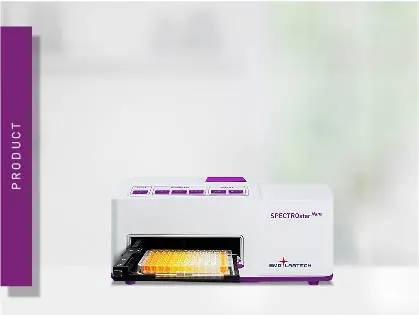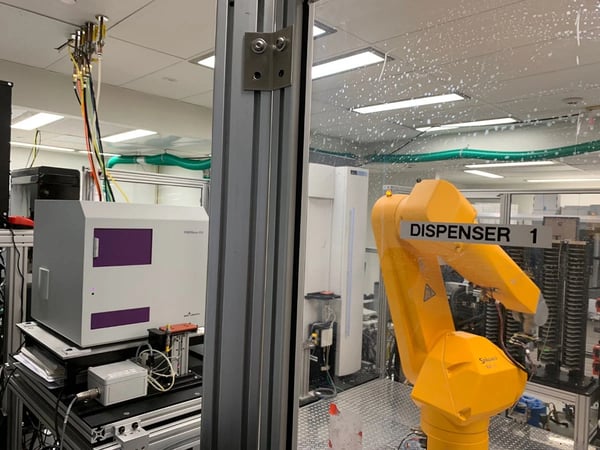
SPECTROstar Nano
Absorbance plate reader with cuvette port
Lab Automation is a key feature in high-throughput screening. Read in this article how you can save time and money with our plate readers.
 Eric Matthews
Eric Matthews
A BMG employee recently described a distant job interview for a position in a lab that was screening thousands of compounds without the benefit of lab automation capabilities. The interview didn’t ever really end, but it did result in a new appreciation for the benefits of laboratory robotics and self-discovery about how fast it’s possible for a person to run in the middle of a job interview.
Obviously, most job applicants do not consider the potential to have a new repetitive stress injury named in their honor to be a perk. So lab automation of all sorts eliminates some of this unpleasantness by eliminating some daily duties that can be repetitive, dull, boring, and repetitive. Lab automation frees scientists to focus on productive and interesting mental tasks. Beyond being labor-saving, lab automation opens up avenues of research that simply aren’t humanly possible without robotics and automated liquid handling.
Many processes are feasible and even widespread before automation improved productivity and distribution. Books existed prior to the printing press. Without automating production, it would still be possible to buy chocolate candy shaped like a large rabbit at Eastertime. With automated processing, chocolate bunnies are available to all consumers at an affordable price point. Handmade chocolates have a place, but the speed of production, consistency, and the volume required to make every child ill by eating a piece of candy the size of a toaster simply wouldn’t be a reality without automation of production. Similarly, molecular biology and drug discovery will advance no matter what tools are available. But the purchase of a microplate reader, a liquid dispensing workstation and a few robot arms immediately turns a potentially Sisyphean ordeal into a minus-80 freezer full of potential oncotherapy targets.
Harvard cancer researcher Judah Folkman became famous for isolating anti-angiogensis cancer therapies but got almost as much mileage in New York Times interviews, seminars and receptions by describing the process necessary to isolate a few micrograms of endostatin from 21 quarts of mouse urine. It’s a thin imagination that doesn’t hear the phrase “21 quarts of mouse urine” and immediately begin calculating how many mice must be necessary for the job, the hours that must be kept to make sure your product of interest is harvested in a timely fashion, exactly how much urine a mouse produces in a day and exactly what sort and number of personal and hygienic principles must be compromised in the pursuit of knowledge. I am probably making it sound more fun than it was. Isolating tiny protein fragments from vast volumes of rodent excrement is fun to contemplate, but it took an extraordinary amount of labor, drive, and potential reward to humanity before it endeavored. There are entire fields of potential investigation that simply don’t exist without lab automation.
BMG Labtech and many of our users appreciate lab automation not just for the kind of research it makes possible or because of feelings of resentment toward tedious pipetting chores, but because wide adoption of lab automation drives a need for detection. Today’s fastest liquid handling robots can dispense into 384-wells in a matter of seconds. Users who don’t want the final step in a process to slow down the rest of their research need detection to happen rapidly. The PHERAstar FSX is the fastest plate reader that has ever been produced—it can accurately read two wavelengths from a 1536 well TR-FRET plate in 27 seconds—so we talk to a lot of researchers who care about accurate, sensitive detection and fast measurement and very little else.
One of the first items in the shopping cart of the lab automation curious is an arm like the Hudson PlateCrane Cyclops. A robot arm can link a plate washer to an incubator and a microplate reader like the CLARIOstar so that busy labs can automate the processing of ELISA or increase the throughput of a popular assay like CellTiter-Glo from Promega. When working with live cells, a robotic arm can shuffle plates back and forth between a plate reader and an incubator, as shown in the video here below.

One of the most significant advances in laboratory automation in the last handful of years has been the introduction of acoustic nanoliter dispensing. Anyone who remembers being at a trade show and seeing Labcyte discuss their new products for the first time likely remembers hearing an engineer say, “The Echo dispenses reagents into your plate without contacting the liquid, by using sound.” And almost certainly followed by the thought, “That does not make any sense.” Using directed acoustics to dispense micro volumes into low-volume plates eliminates the cost and hassle that comes with buying, using, and disposing of pipette tips. And it also eliminates the common pipette-related issues of dilution, waste, and potential cross-contamination. Lab automation users who would like to automate drug discovery screening operations, ADME-Tox, cell-based assays, or biochemical assays can use far less reagent and read more samples quickly while reducing assay costs per well. Acoustic dispensing makes 1536- and 3456-well plate detection a feasible possibility. Coupled with a HTS reader like the PHERAstar FSX, a smoothly operating lab can generate over 122,000 wells per hour.
If you’re interested in learning more about what kinds of assays can be automated in your lab, please spend some time looking at application notes and publications at BMG’s applications center.
Absorbance plate reader with cuvette port
Powerful and most sensitive HTS plate reader
Most flexible Plate Reader for Assay Development
Upgradeable single and multi-mode microplate reader series
Flexible microplate reader with simplified workflows
Molecular glues are small molecules that help target unwanted proteins for destruction by the ubiquitin-proteasome system. Find out how microplate readers can advance molecular glue research.
Cannabinoids offer exciting opportunities to target diverse diseases with unmet needs. Learn how microplate readers can help improve our understanding of drug screening and drug signaling events to help advance cannabinoid research.
PROTACs are small, readily designed molecules that target unwanted proteins to the cell’s ubiquitin-proteasome system for degradation. Find out how microplate readers can advance PROTAC research.
Measuring light scattering is an accurate and expedient way to determine drug solubility. Find out how the NEPHELOstar® Plus can be used for early drug solubility screening at high throughput.
Mitochondrial toxicity can have devastating effects on the cell and life. Find out how microplate readers can be used to assess mitochondrial health and how this impacts disease and drug discovery.
The investigation of binding kinetics is crucial for drug research. Find out, how binding kinetics work and which approaches can be used to study them on microplate readers.